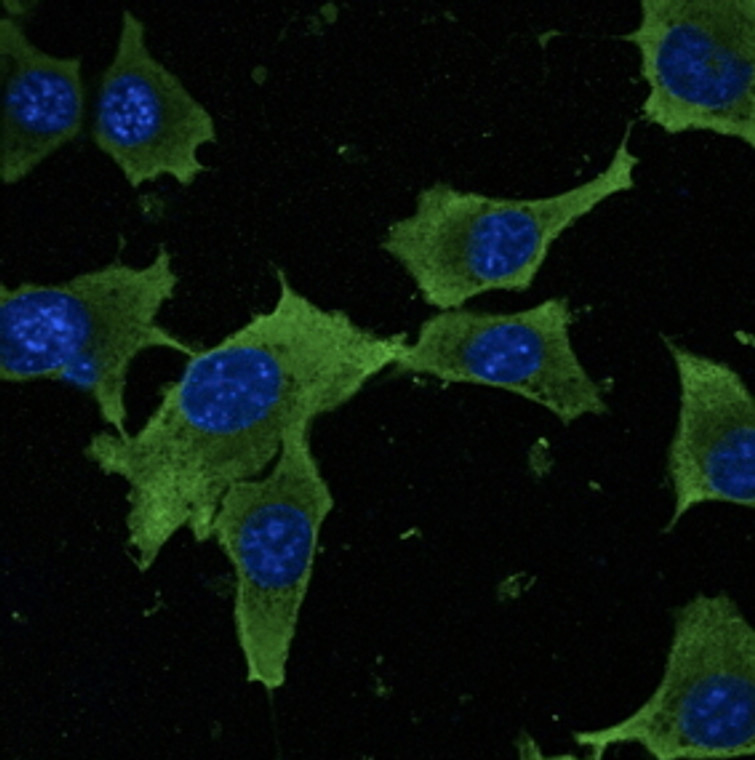| Host: |
Goat |
| Applications: |
WB/IHC-F/IHC-P/IF |
| Reactivity: |
Human/Rat/Mouse/Monkey/Canine |
| Note: |
STRICTLY FOR FURTHER SCIENTIFIC RESEARCH USE ONLY (RUO). MUST NOT TO BE USED IN DIAGNOSTIC OR THERAPEUTIC APPLICATIONS. |
| Short Description: |
Goat polyclonal antibody anti-Glyceraldehyde-3-phosphate dehydrogenase (240aa C-Term) is suitable for use in Western Blot, Immunohistochemistry and Immunofluorescence research applications. |
| Clonality: |
Polyclonal |
| Conjugation: |
Unconjugated |
| Isotype: |
IgG |
| Formulation: |
PBS, 20% Glycerol and 0.05% Sodium Azide. |
| Purification: |
This antibody is epitope-affinity purified from goat antiserum. |
| Concentration: |
2 mg/mL |
| Dilution Range: |
WB 1:500-1:10000IF 1:50-1:250IHC-P 1:200-1:1000IHC-F 1:200-1:1000Ramos S Ademolue TW Jentho E et al. Cell Metab 2022 Aug PMID: 35841892Broughton K Korski K Echeagaray O et al. Gene Ther. 2019 Aug PMID: 31239537Korski KI |
| Storage Instruction: |
For continuous use, store at 2-8 C for one-two days. For extended storage, store in-20 C freezer. Working dilution samples should be discarded if not used within 12 hours. |
| Gene Symbol: |
GAPDH |
| Gene ID: |
2597 |
| Uniprot ID: |
G3P_HUMAN |
| Immunogen Region: |
240aa C-Term |
| Accession Number: |
ENSG00000111640 |
| Specificity: |
Detects a band of 37 kDa by Western blot in the following human (293A, HMEC-1, U-118, HaCat) , rat (TR-iBRB) , mouse (AtT-20, Hepa) , canine (D17) and monkey (COS-7) whole cell lysates. |
| Immunogen: |
Purified recombinant peptide derived from within residues 240 aa to the C-terminus of human GAPDH produced in E. coli. |
| Post Translational Modifications | S-nitrosylation of Cys-152 leads to interaction with SIAH1, followed by translocation to the nucleus. S-nitrosylation of Cys-247 is induced by interferon-gamma and LDL(ox) implicating the iNOS-S100A8/9 transnitrosylase complex and seems to prevent interaction with phosphorylated RPL13A and to interfere with GAIT complex activity. ISGylated. Sulfhydration at Cys-152 increases catalytic activity. Oxidative stress can promote the formation of high molecular weight disulfide-linked GAPDH aggregates, through a process called nucleocytoplasmic coagulation. Such aggregates can be observed in vivo in the affected tissues of patients with Alzheimer disease or alcoholic liver cirrhosis, or in cell cultures during necrosis. Oxidation at Met-46 may play a pivotal role in the formation of these insoluble structures. This modification has been detected in vitro following treatment with free radical donor (+/-)-(E)-4-ethyl-2-(E)-hydroxyimino-5-nitro-3-hexenamide. It has been proposed to destabilize nearby residues, increasing the likelihood of secondary oxidative damages, including oxidation of Tyr-45 and Met-105. This cascade of oxidations may augment GAPDH misfolding, leading to intermolecular disulfide cross-linking and aggregation. Succination of Cys-152 and Cys-247 by the Krebs cycle intermediate fumarate, which leads to S-(2-succinyl)cysteine residues, inhibits glyceraldehyde-3-phosphate dehydrogenase activity. Fumarate concentration as well as succination of cysteine residues in GAPDH is significantly increased in muscle of diabetic mammals. It was proposed that the S-(2-succinyl)cysteine chemical modification may be a useful biomarker of mitochondrial and oxidative stress in diabetes and that succination of GAPDH and other thiol proteins by fumarate may contribute to the metabolic changes underlying the development of diabetes complications. (Microbial infection) Glycosylated by C.rodentium protein NleB, enteropathogenic E.coli protein NleB1 and S.typhimurium protein Ssek1: arginine GlcNAcylation prevents the interaction with TRAF2 and TRAF3. This leads to reduced ubiquitination of TRAF2 and TRAF3, and subsequent inhibition of NF-kappa-B signaling and type I interferon production, respectively. |
| Function | Has both glyceraldehyde-3-phosphate dehydrogenase and nitrosylase activities, thereby playing a role in glycolysis and nuclear functions, respectively. Glyceraldehyde-3-phosphate dehydrogenase is a key enzyme in glycolysis that catalyzes the first step of the pathway by converting D-glyceraldehyde 3-phosphate (G3P) into 3-phospho-D-glyceroyl phosphate. Modulates the organization and assembly of the cytoskeleton. Facilitates the CHP1-dependent microtubule and membrane associations through its ability to stimulate the binding of CHP1 to microtubules. Component of the GAIT (gamma interferon-activated inhibitor of translation) complex which mediates interferon-gamma-induced transcript-selective translation inhibition in inflammation processes. Upon interferon-gamma treatment assembles into the GAIT complex which binds to stem loop-containing GAIT elements in the 3'-UTR of diverse inflammatory mRNAs (such as ceruplasmin) and suppresses their translation. Also plays a role in innate immunity by promoting TNF-induced NF-kappa-B activation and type I interferon production, via interaction with TRAF2 and TRAF3, respectively. Participates in nuclear events including transcription, RNA transport, DNA replication and apoptosis. Nuclear functions are probably due to the nitrosylase activity that mediates cysteine S-nitrosylation of nuclear target proteins such as SIRT1, HDAC2 and PRKDC. |
| Protein Name | Glyceraldehyde-3-Phosphate DehydrogenaseGapdhPeptidyl-Cysteine S-Nitrosylase Gapdh |
| Database Links | Reactome: R-HSA-70171Reactome: R-HSA-70263 |
| Cellular Localisation | CytoplasmCytosolNucleusPerinuclear RegionMembraneCytoskeletonTranslocates To The Nucleus Following S-Nitrosylation And Interaction With Siah1Which Contains A Nuclear Localization SignalPostnuclear And Perinuclear Regions |
| Alternative Antibody Names | Anti-Glyceraldehyde-3-Phosphate Dehydrogenase antibodyAnti-Gapdh antibodyAnti-Peptidyl-Cysteine S-Nitrosylase Gapdh antibodyAnti-GAPDH antibodyAnti-GAPD antibodyAnti-CDABP0047 antibodyAnti-OK antibodyAnti-SW-cl.12 antibody |
Information sourced from Uniprot.org
12 months for antibodies. 6 months for ELISA Kits. Please see website T&Cs for further guidance








